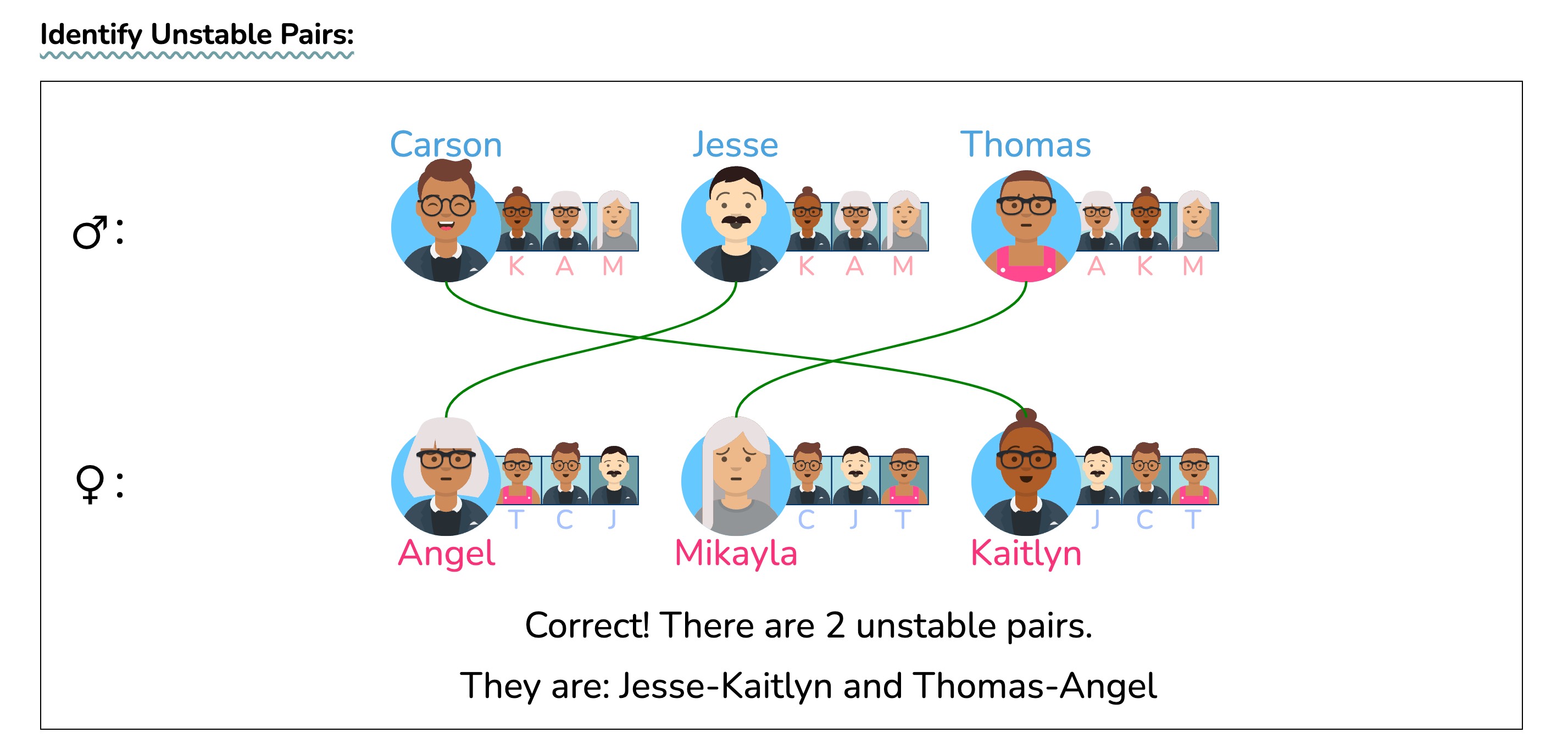Table of Contents
介绍,以及手动推算unstable matching pairs
🔗 [Gale–Shapley algorithm - Wikipedia] https://en.wikipedia.org/wiki/Gale–Shapley_algorithm
就是稳定匹配算法/stable matching algorithm.
举例:
假设有100男+100女,各自都有编号。每个女性都维护一个属于自己的优先级表,里面是所有男性成员的优先级排序(从高到低,不能有遗漏,不能重复,正好100个);每个男性都维护一个属于自己的优先级表,里面是所有女性成员的优先级排序(从高到低,不能有遗漏,不能重复,正好100个)。
所以说这里面一共要存储200个”排序表“,每个排序表100个元素,一共200*100=20000个元素。
Gale-shapley algorithm的作用是:给出一个匹配方案,让这100男+100女的人群中不存在“不稳定风险”/“不稳定匹配”。
上面的“不稳定风险”实际上在正规资料里应该被称为unstable matching,这个笔记里先这么写的原因是方便理解。
🔗 [Stable Matching Solution Visualized] https://uw-cse442-wi20.github.io/FP-cs-algorithm/
最简单的例子:

一点铺垫:
假设有N个男性,N个女性,那么我应该有[mathjax]N![/mathjax]种匹配方案。
最关键的来了:要验证一个现有的匹配是不是stable matching,就要把所有“可能造成unstable matching“的潜在匹配都验证一遍(验证是不是unstable),如果存在一个unstable matching,那整个匹配方案就不稳定,需要换一种匹配方案。
寻找所有的unstable matching = 遍历所有潜在匹配 = 遍历所有当前匹配之外的连接(一共检查[mathjax]N(N-1)[/mathjax]个),而不是检查当前匹配是不是unstable.
比如100男x100女,男性-027当前被匹配到女性-039,要想完全挖掘这个男性-027的潜在不稳定匹配,就要把 男性027 x (女性001~女性100,排除女性039)这99个潜在匹配都验证一遍。同理,女性039也要验证99个潜在匹配:女性039 x (男性001~男性100,排除男性027).
也就是说,对于一个[mathjax]N[/mathjax] x [mathjax]N[/mathjax]的匹配系统,要想验证一个现有的匹配是不是stable matching,就要检验[mathjax]N(N-1)[/mathjax]个潜在匹配。(当然,如果无需列举所有unstable matching,那么只需找到一个unstable matching就可以提前终止寻找)
举例如下:
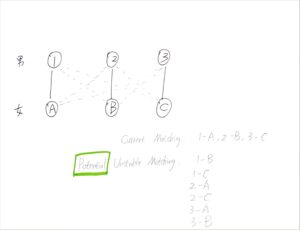
基本顺序就是:
- 列出所有potential unstable matching(一共[mathjax]N(N-1)[/mathjax]个)(事先决定男-女或者女-男然后跑一遍即可,不需要跑2遍),然后逐一开始检查
- 对每个要检验的potential unstable matching:看看这个方案是不是比当前方案对男女双方而言都更优。具体大概可以解释为:假设当前的匹配为[mathjax](P, Q)[/mathjax],[mathjax]Q[/mathjax]在[mathjax]P[/mathjax]心中的排名为第n名。如果现在来了个[mathjax]Q^{\prime}[/mathjax],她在[mathjax]P[/mathjax]心中的排名比(当前[mathjax]Q[/mathjax]的)第n名靠前,而且[mathjax]P[/mathjax]在[mathjax]Q^{\prime}[/mathjax]心中的排名也比[mathjax]Q^{\prime}[/mathjax]当前匹配的[mathjax]P^{\prime}[/mathjax]靠前,那么[mathjax](P, Q^{\prime})[/mathjax]就是一对unstable matching. 注意到虽然上面提到了[mathjax]P^{\prime}[/mathjax],也就是[mathjax]Q^{\prime}[/mathjax]当前的匹配对象,但[mathjax]P^{\prime}[/mathjax]只参与排名计算,并不会列入最终的unstable matching结果中。这是因为我们目前只在处理[mathjax](P, Q^{\prime})[/mathjax]的问题,[mathjax]P^{\prime}[/mathjax]还没轮到(或者已经轮完了)。
在🔗 [Stable Matching Solution Visualized] https://uw-cse442-wi20.github.io/FP-cs-algorithm/ 有一个demo,每次都能随机生成一个检查stable matching的题目。
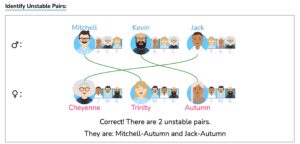
过程如下:
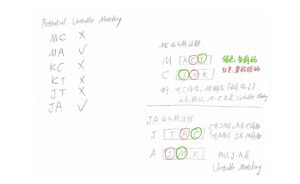
实际上,在做上面这道题的时候可以在某些地方加快一点进度:当我们发现K的当前匹配(对K而言)是最优的时候,所有K相关的potential unstable matching都可以直接打叉了,因为不可能存在比K-A更优的匹配;当然对A而言并不是这样,因为K排在A排名的最后一名,所以我们计算其他unstable matching的时候还要把A带上,最终我们发现J-A和M-A是unstable的。
还有4道题供练习用(不够的话去🔗 [Stable Matching Solution Visualized] https://uw-cse442-wi20.github.io/FP-cs-algorithm/ 随机生成即可):
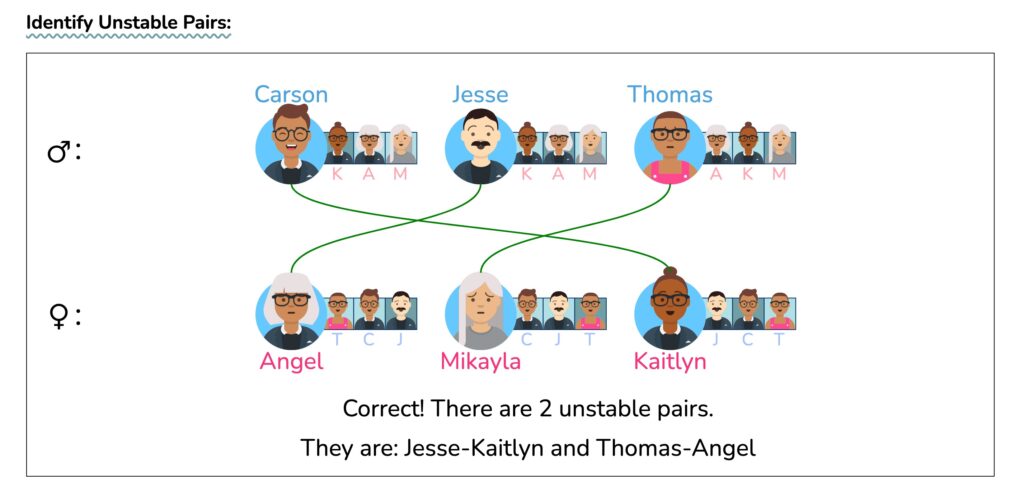
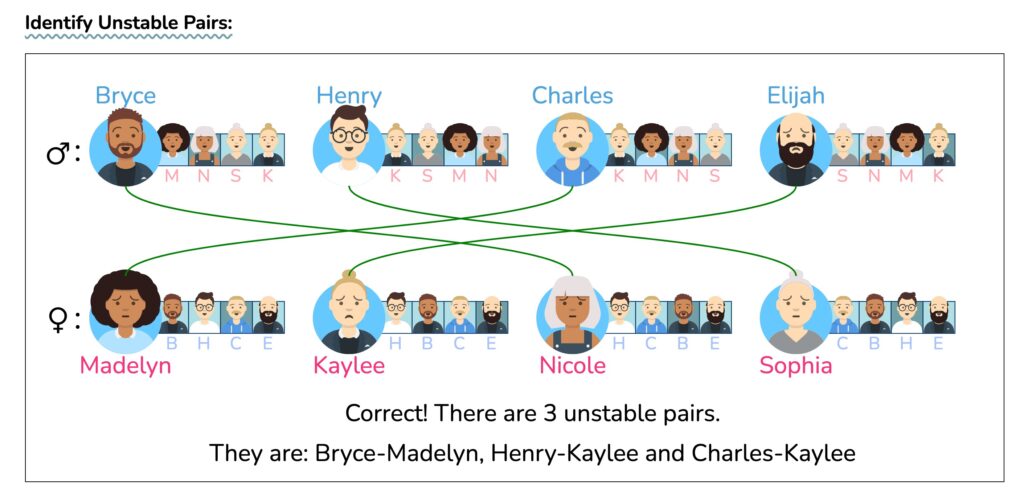
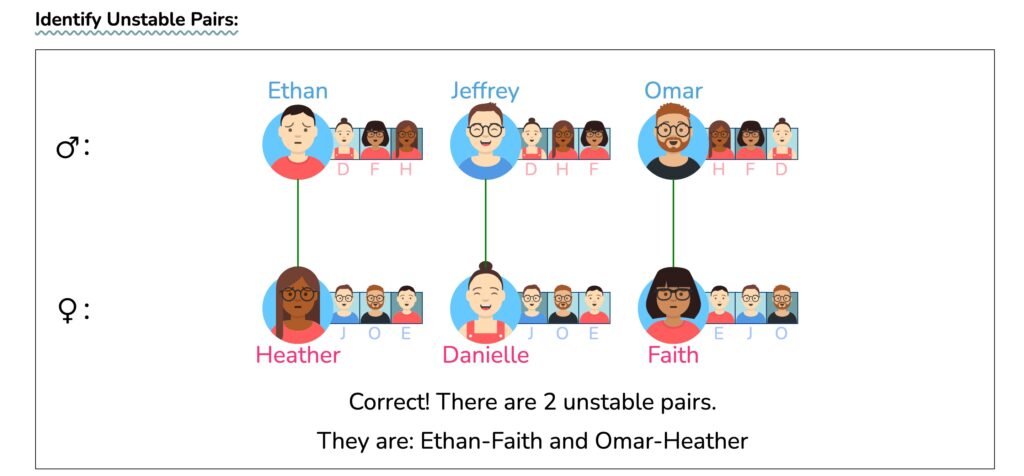
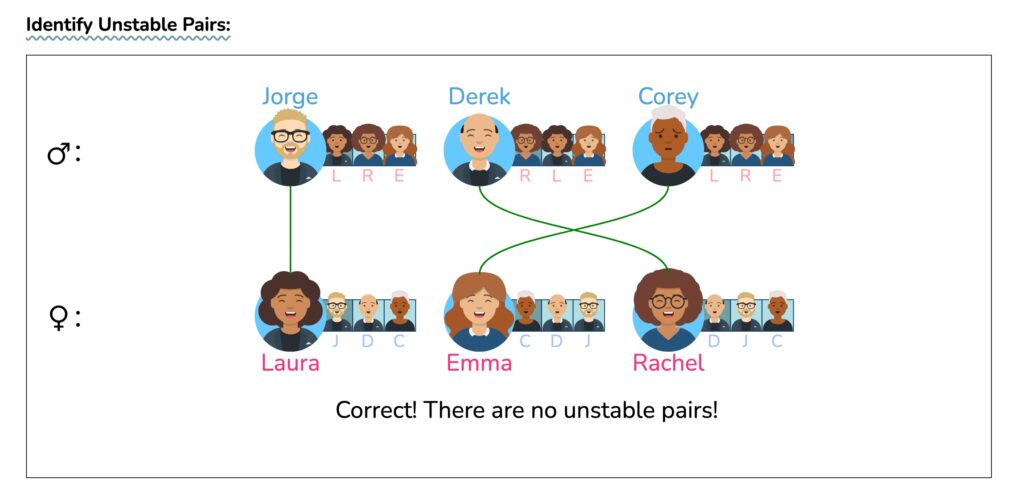
以上就是 检验 stable matching的方法。
代码应用
大致思路
为了简便,本笔记会手动实现一个 检验 stable matching的算法;stable matching的 求解 由python matching包提供。
从这里开始:
🔗 [daffidwilde/matching: A package for solving matching games] https://github.com/daffidwilde/matching
搞了半天,发现:
- 除了stable marriage问题,还有一个student allocation问题,但本篇笔记就暂时不涉及了
- matching包只提供对student allocation问题的检验,而且(似乎)只输出true/false,不详细列举
- 所以stable marriage的检验算法还得自己写一个
大致顺序:
- 手写一个函数,列举出当前匹配方案的所有unstable matching(如果没有则返回空)
- 用本笔记上面的例题(来自🔗 [Stable Matching Solution Visualized] https://uw-cse442-wi20.github.io/FP-cs-algorithm/ )检验函数写得对不对
- 随机生成100男-100女,偏好完全随机的场景,用matching包去求解stable matching solution
- 把求解得到的stable matching solution放进第(1)步的函数里验证,如果这个解确实是stable的,那么函数应该返回一个空数组
- 第(3~4)步的随机场景可以重复多次,看看是不是每次求得的解都是stable的
- 如果上述程序都按计划执行,那么python [matching]包就是我最终想要的东西,以后可以使用它了。
关于第5步:gale-shapley是一定能得到stable matching solution的,所以只要程序没问题,第5步无论随机多少次都都是stable solution.
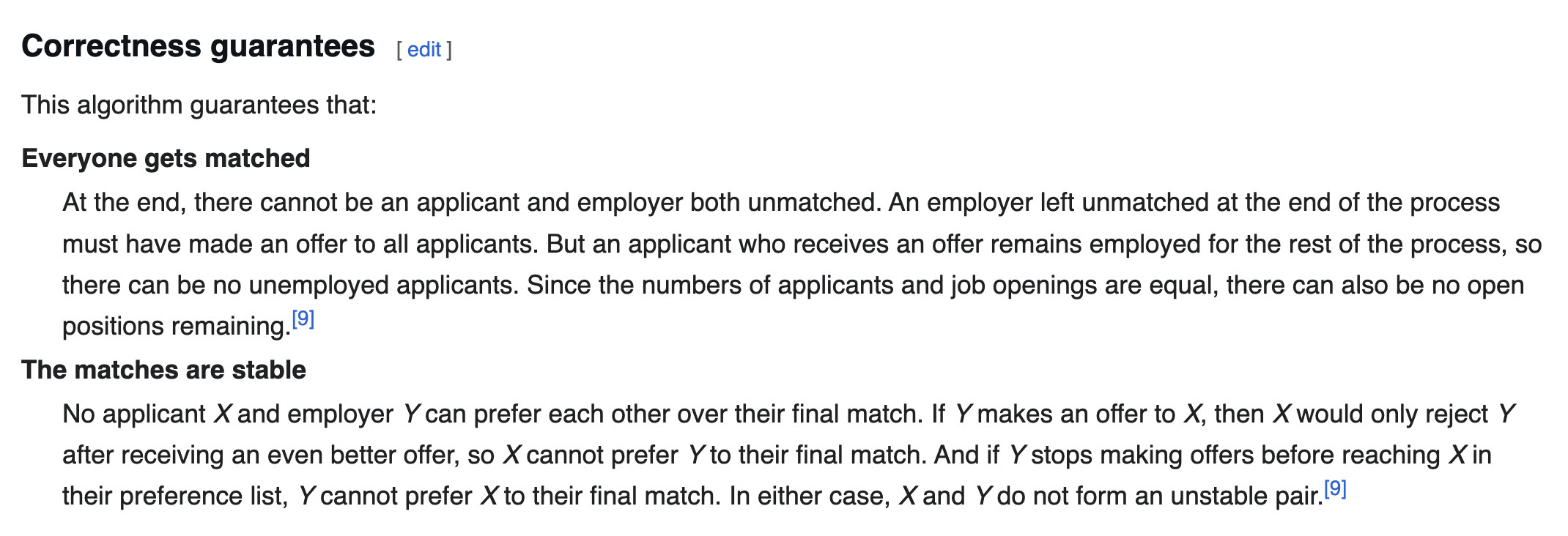
数据输入
首先是python matching包的数据变量写法:

上面这张图的关系以及匹配被写为:
groupA_preferences = {
"M": ["A", "C", "T"],
"K": ["A", "T", "C"],
"J": ["T", "A", "C"],
}
groupB_preferences = {
"C": ["J", "M", "K"],
"T": ["M", "J", "K"],
"A": ["J", "M", "K"],
}
current_matching = {"M": "T", "K": "A", "J": "C"}用于检验unstable matching的函数
然后是用于检验并列举unstable matching pairs的函数:
def search_dict_key(dict, value):
for key, val in dict.items():
if val == value:
return key
def check_unstable_pairs(groupA_preferences: dict, groupB_preferences: dict, current_matching: dict):
unstable_pairs = [] # format: [(a1, b1), (a2, b2), ...]
for groupA_test in groupA_preferences.keys():
for groupB_test in [val for val in groupB_preferences.keys() if val != current_matching[groupA_test]]:
if groupA_preferences[groupA_test].index(groupB_test) < groupA_preferences[groupA_test].index(current_matching[groupA_test]) and groupB_preferences[
groupB_test].index(groupA_test) < groupB_preferences[groupB_test].index(search_dict_key(current_matching, groupB_test)):
unstable_pairs.append((groupA_test, groupB_test))
return unstable_pairs调用:
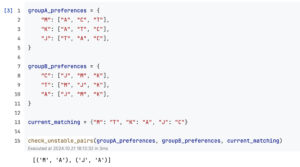
以及另一个例子:
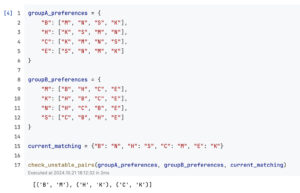
求解gale-shapley(调包)
简单的例子检验的差不多了,开始进行步骤3~4
先确认python recursion limit至少有1500
import sys
sys.getrecursionlimit() # 100-100的gale-shapley大概需要1500的recursion limit
# 如果要尝试>100的gale-shapley就需要把recursion limit调大
# sys.setrecursionlimit(4500)然后开始生成100-100的男女群组,赋予随机偏好优先级列表,用python matching包求解,然后把求解的结果用前面手写的 check_unstable_pairs 检验:
groupA_preferences = {}
groupB_preferences = {}
current_matching = {}
groupA_ids = [f"A_{idx}" for idx in range(0, 100)]
groupB_ids = [f"B_{idx}" for idx in range(0, 100)]
for id_A in groupA_ids:
groupA_preferences[id_A] = random.sample(groupB_ids, len(groupB_ids))
for id_B in groupB_ids:
groupB_preferences[id_B] = random.sample(groupA_ids, len(groupA_ids))
groupB_ids_copy = deepcopy(groupB_ids)
for id_A in groupA_ids:
random_B = random.choice(groupB_ids_copy)
current_matching[id_A] = random_B
groupB_ids_copy.remove(random_B)
print(f'Use random matching, there are {len(check_unstable_pairs(groupA_preferences, groupB_preferences, current_matching))} unstable matching pairs')
game = StableMarriage.create_from_dictionaries(
groupA_preferences, groupB_preferences
)
game_matching = dict(game.solve(optimal="suitor"))
stable_matching = {}
for key, val in game_matching.items():
stable_matching[str(key)] = str(val)
print(f'Use Gale-shapley algorithm, there are {len(check_unstable_pairs(groupA_preferences, groupB_preferences, stable_matching))} unstable matching pairs')运行结果(第一行:每次运行的结果都不一样;第二行:要确保为0)
Use random matching, there are 2311 unstable matching pairs
Use Gale-shapley algorithm, there are 0 unstable matching pairs多次运行以反复验证
最后是第5步:重复上面的“随机100-100多次”:
代码就不贴了,总之就是上面的代码外面套一层while循环,每次都检验一下 check_unstable_pairs 是不是返回了长度为0的数组。
我跑了25000次都是正确的,所以就认为上面的代码没有问题了。
代码汇总
代码汇总:
